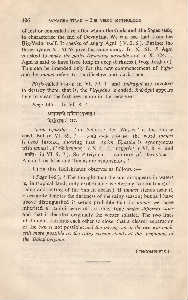Page 760 - Lokmanya Tilak Samagra (khand 2)
P. 760
106 SAMAGRA TILAK --2 • VEDIC MYTHOLOGY
of lost or concealed fire, after whom the Gods and the Sages seek,
to characterise the end of Devayana. We can see that from the
:Rig-Veda itself. It speaks of angry Agni ( V. 2. 8 ). Further the
three hymns X. 51-53 give the same story. In X. 51. 5 Agni
is asked to make the paths Devaydna passable and in X. 124. 1,
Agni is said to have lived long in deep darkness ( Jyog dirghan ).
This can be intended only for the new commencement of Yajna
and by tamas refers to sacrificeless and dark time.
Pitriscalled ~: in VI. 59. I and Indrdgni are invoked
to destroy them, that is, the Pitriydna is ended. Indrdgni appears
here to mean the first new moon in the new year.
Page 145- In VI. 8. 4 :-
~~lt~S~al
fcfm'f~;:{ etc.
Apam Updsthe - ' un Schoose der Wasser ' is the phrase
used. But in VI. 89. 7 :- c<fl'ffi ~fu ID~:q<fffi 1 the word tamasi
is used instead, showing that Apa.m Upasthe is synonymous
with tamasi . ( '~r ~9<iRI"l:,_' in X. 51. 5; '<>111mtr~' in VI. 8. 4; and
'Qllfu' in VI. 9. 7 ). So Pitriyfma- contrary of Devayana-
Apam Upashtha and Tamas are synonymous !
Upon this Hellebrandt observes as follows :-
(Page I4Q ). 'The thought that the sun disappears in waters
is, in tropical land, only explainable as referring to rain time ( cf :
rising and setting of the Sun in ocean ). If tamasi stands near it,
it certainly denotes the darkness of the rainy season; but as I have
above distinguished it seems probable that in tamas we have
inherited a reminiscence of an older time under different skies
and that it denoted originally the winter solstice. The two lines
of thought, run into each other so close, that a clearer separation
of the two is not possible: and the mixing up of the two was made
still more possible as the rainy season stands at the beginning of
Jhe Dak~hif}dyana. '
(INCOMPLETE)

